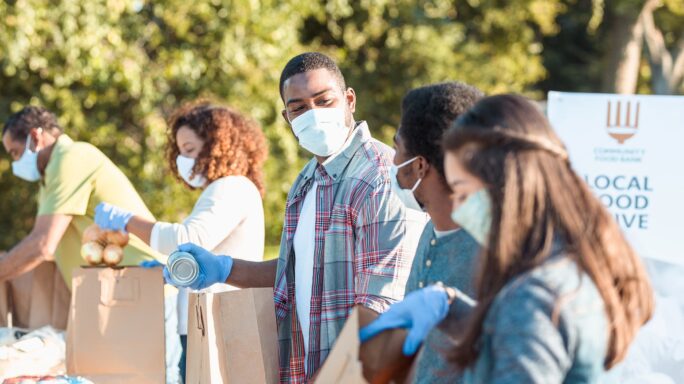Technology & Innovation
[Webinar] 4 major shifts driving the Future of Finance

The threat of a third COVID wave and stricter lockdown rules looms larger every day.
By now, everyone knows the precautions to take to prevent the virus’s spread. For the most part, these precautions are proactive, like wearing masks, sanitising hands, and staying home. But what about the next 12 months? And the next?
No one knows how long COVID will be around for. Overcoming the pandemic depends on individuals and businesses making wise, foresighted decisions to mitigate new waves, which suggests that merely being proactive is no longer enough.
So says Bronwyn Williams, economist and trends analyst at Flux Trends, speaking during a Sage Power Session on the Future of Finance. She adds that we need to start thinking further ahead, especially since some things have fundamentally changed and will never return to any sense of normal.
The more some things change, the more others stay the same
To get a better idea of where the world is headed, it helps to understand the deeper macro trends driving human behaviour, such as a desire to connect with other people and a desire to progress. These drivers will never change, says Bronwyn.
“Maybe going back to the workplace isn’t going to be nine-to-five, in your cubicle, like it was before. But that doesn’t mean that we’re going to stop connecting with each other in person. We’re still going to get together and break bread, it just won’t be as easy or as often as it was at the office.”
She adds that businesses need to shift their thinking and approaches when it comes to meeting humans’ need for connection and belonging, and starting with these four areas can have a massive impact.
Shift 1: From on-demand to anticipatory business models
People want things when they want them – not “sometime before 5 pm”. The lesson for businesses, says Bronwyn, is quite simple.
“It means that you have to meet your clients, suppliers, or whoever you’re dealing with in your supply chain at their point in need, at that point in time, rather than expecting people to come and find you or ask you for information.”
That’s right. Just as businesses were getting used to the idea of instant gratification, the on-demand economy comes along and demands even more. Now, businesses must move away from just-in-time operating models to anticipatory forms of service, where science, technology, and humanity combine.
Bronwyn uses the example of WumDrop, a last-mile, on-demand delivery and driver crowdsourcing service that lets users track their deliveries in real-time. It anticipates where you’ll be, and the driver meets you there. This service is made possible by WumDrop’s automation and optimisation software and is an example of how technology can connect people in exciting ways.
For the finance function to offer this level of service, it must shift away from retrospective data and start dealing with real-time data, says Bronwyn. Sage Intacct allows financial decision-makers to pre-empt and avoid mistakes and not just course-correct when things have already gone wrong.
Shift 2: From sustainability as an afterthought to a deal-breaker
COVID put sustainability in the spotlight. At the same time that the pandemic was spreading, so too were Australia’s wildfires and, for the first time, the United Nations recognised climate refugees coming out of that country.
When we talk about sustainability, says Bronwyn, it’s usually about reducing waste, consuming less, and ensuring we don’t overshoot our natural resource endowments. But that’s just one component; the other, she says, is about social sustainability.
“Imagine a doughnut with its two concentric rings,” she says, referencing Oxford economist Kate Raworth’s theory of doughnut economics. One ring represents a social foundation to ensure that everyone has access to life’s essentials. The other ring represents an ecological ceiling to ensure these needs are met within the planet’s means. Between these boundaries is a doughnut-shaped space that is both ecologically safe and socially just: a space in which humanity can thrive.
“Businesses are starting to realise that they can only thrive in a society that’s also thriving. More and more businesses are tying executive pay packages to sustainability targets. Environmental, social, and corporate governance (ESG) type business models and investment structures are gaining prominence. Companies refuse to work with organisations that don’t behave sustainably. Some banks won’t finance businesses they don’t deem to be operating sustainably. This is the biggest long-term shift we’re seeing, and there’s pressure to remain within that proverbial doughnut.”
Shift 3: From siloes to hyper-connections
The CFO’s role has evolved dramatically over the past year. No longer just the person who signs the cheques, senior financial decision-makers must embrace macro-level trends within their roles, so that they and their organisations are not swept away by change.
“If CFOs want to be proactive against change; if they want to anticipate opportunities and be forewarned against emerging threats; they must start looking outside of their individual and organisational siloes,” says Bronwyn.
This can be a challenge in enterprises that are set up for efficiencies in achieving a particular goal, she notes. And since organisations naturally silo and humans automatically form cliques with people they get along with, breaking down siloes is easier said than done.
The consequence, however, is that businesses lose resiliency and the ability to spot emerging threats. But they can guard against the formation of siloes by connecting more nodes within and outside the organisation.
“Nodes are important from an organisational theory perspective. The more nodes, or connections, that you have across departments and at all levels of the organisation, the more resilient your network becomes. Every person, every node within your network, has a different perspective and sees the world in a slightly different way. That diversity is priceless,” says Bronwyn.
When it comes to recruitment, she advises that businesses aim for ‘3D diversity’.
“3D diversity goes beyond demographic scorecards and extends to hiring people with different viewpoints, experience, and backgrounds. You can have a demographically diverse team, but if they all studied the same degree at the same university, you’re not going to get that flow of innovation and ideas that you’re aiming for. You’re not going to spot emerging opportunities and threats as much as a team that has a more hybrid diversity.”
The flow of creative ideas depends on these connections, and organisations should focus on developing communication, leadership, and selling skills.
Shift 4: From fearing tech will replace us to embracing it to make us better
Webinar attendees were polled on the biggest challenges preventing them from embracing the Future of Finance. The majority (41%) selected “Identifying and selecting the best-fit technology for my business”.
Technology allows us to operate more efficiently by automating anything that slows us down or is seen as a cost centre in the business, says Bronwyn. And while she acknowledges that technology will always automate away tasks and that certain functions and jobs will disappear, it can’t automate away work entirely or our place as human beings in society.
“We might not have jobs as we know them today, but there is always space for people to add value through creativity, especially in terms of spotting the new. You cannot program the new or the next. Someone has to come up with the new service, opportunity, or idea; you can only automate what has gone before, which is why people are essential in an organisation that’s trying to build foresightedness.”
As team leaders, CFOs should work hard to remove any tasks that can be automated from their roles. When you’re not bogged down by the details, you get a bird’s eye view of what’s going on in your business and your industry. The further you progress within an organisation, the more you should be scanning the horizon for threats, blindspots, and opportunities.
“I always advise businesses to use technology to get rid of their pain-points – stuff you hate doing, the nonsense, the annoying work. There are indications that this wave of automation will displace and change the nature of work rather than replace humans altogether. The added value comes from the humans in your business. With the menial tasks automated, they can focus on the value centre tasks that are not easily automatable.”
She cautions, however, that anything that can be automated can also be replicated and commoditised. Businesses should never automate value-based functions because, once they do, those functions become commodities that anyone can copy.
“It’s hard to look beyond our immediate circumstances; there’s always something urgent that needs to be dealt with. But if we only focus on what’s urgent, we lose sight of the bigger picture, we lose foresight, and we lose the ability to anticipate problems before they happen.
Future of Finance Webinar Series
Watch Sage experts and Bronwyn Williams, economist and trends analyst, for insight to help your business adapt to today’s ever-changing environment and prepare for future growth.









Ask the author a question or share your advice